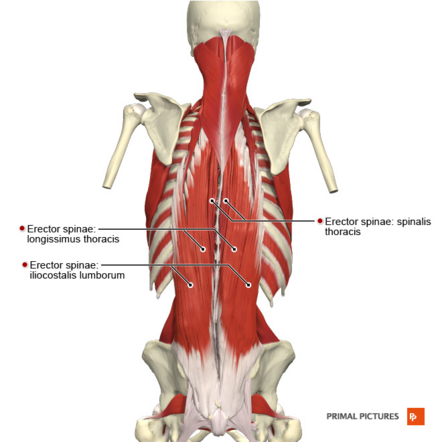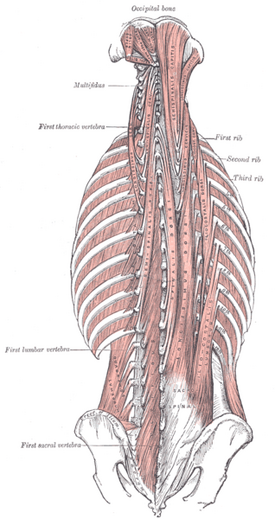Erector Spinae: Difference between revisions
Abbey Wright (talk | contribs) No edit summary |
Abbey Wright (talk | contribs) (added new image) |
||
| Line 5: | Line 5: | ||
</div> | </div> | ||
== Introduction == | == Introduction == | ||
[[File:Muscles of the back erector spinae group Primal.png|thumb|442x442px]] | |||
The erector spinae muscle, also known as sacrospinalis and extensor spinae in some texts is from the deep muscles of the back. It lies superficial to the [[transversospinales]] muscle group and deep to the intermediate group of back muscles ([[serratus posterior]] superior and inferior).<ref name=":0" /><ref name=":1">Drake R, Vogl AW, Mitchell AW. Gray's Anatomy for Students E-Book. Elsevier Health Sciences; 2009 Apr 4.</ref> | The erector spinae muscle, also known as sacrospinalis and extensor spinae in some texts is from the deep muscles of the back. It lies superficial to the [[transversospinales]] muscle group and deep to the intermediate group of back muscles ([[serratus posterior]] superior and inferior).<ref name=":0" /><ref name=":1">Drake R, Vogl AW, Mitchell AW. Gray's Anatomy for Students E-Book. Elsevier Health Sciences; 2009 Apr 4.</ref> | ||
The erector spinae muscle extends the vertebral column. <ref name=":0">Whitmore I. [https://onlinelibrary.wiley.com/doi/full/10.1002/%28SICI%291097-0185%2819990415%29257%3A2%3C50%3A%3AAID-AR4%3E3.0.CO%3B2-W Terminologia anatomica: new terminology for the new anatomist]. The Anatomical Record: An Official Publication of the American Association of Anatomists. 1999 Apr 15;257(2):50-3.</ref> It is formed of 3 muscles and its fibres run more or less vertically throughout the [[lumbar]], [[Thoracic Anatomy|thoracic]] and [[Cervical Anatomy|cervical]] regions. It lies in the groove to the side of the vertebral column. In cervical region it is covered by [[Ligamentum nuchae|nuchal]] ligament and in thoracic and lumber region by [[Thoracolumbar Fascia|thoracolumbar fascia]]. | The erector spinae muscle extends the vertebral column. <ref name=":0">Whitmore I. [https://onlinelibrary.wiley.com/doi/full/10.1002/%28SICI%291097-0185%2819990415%29257%3A2%3C50%3A%3AAID-AR4%3E3.0.CO%3B2-W Terminologia anatomica: new terminology for the new anatomist]. The Anatomical Record: An Official Publication of the American Association of Anatomists. 1999 Apr 15;257(2):50-3.</ref> It is formed of 3 muscles and its fibres run more or less vertically throughout the [[lumbar]], [[Thoracic Anatomy|thoracic]] and [[Cervical Anatomy|cervical]] regions. It lies in the groove to the side of the vertebral column. In cervical region it is covered by [[Ligamentum nuchae|nuchal]] ligament and in thoracic and lumber region by [[Thoracolumbar Fascia|thoracolumbar fascia]]. | ||
It is made up of 3 muscles: | It is made up of 3 muscles: | ||
*Medially by Spinalis | *Medially by Spinalis | ||
*Centrally by Longissimus | *Centrally by Longissimus | ||
*Laterally by Illiocostalis | *Laterally by Illiocostalis | ||
Each of these have 3 parts | Each of these have 3 further parts: | ||
{| class="wikitable" | |||
{| | |+ | ||
!Spinalis | |||
!Longissimus | |||
!Illiocostalis | |||
|- | |- | ||
| | |[[Spinalis Capitis|spinalis capitis]] | ||
| | |[[Longissimus Capitis|longissimus capitis]] | ||
| | |illiocostalis cervicis | ||
|- | |- | ||
| spinalis | |[[Spinalis Cervicis|spinalis cervicis]] | ||
| longissimus | |longissimus cervicis | ||
| illiocostalis | |illiocostalis thoracis | ||
|- | |- | ||
| spinalis | |spinalis thoracis | ||
|[[Longissimus Thoracis|longissimus thoracis]] | |||
|illiocostalis lumborum | |||
| | |||
| longissimus thoracis | |||
| illiocostalis lumborum | |||
|} | |} | ||
== Anatomy == | == Anatomy == | ||
| Line 90: | Line 84: | ||
=== Iliocostalis === | === Iliocostalis === | ||
Is is the most lateral part of the erector spinae muscles. It attaches to the ribs.<ref name=":1" /> Due to the lateral position, tightness in iliocostalis muscles can force the ipsilateral hip into a superior position, or bring the ribcage inferior toward the hip. | [[Image:Erector spinae.png|519x519px|alt=|left]]Is is the most lateral part of the erector spinae muscles. It attaches to the ribs.<ref name=":1" /> Due to the lateral position, tightness in iliocostalis muscles can force the ipsilateral hip into a superior position, or bring the ribcage inferior toward the hip. | ||
It is divided into 3 parts:<ref name=":2" /> | It is divided into 3 parts:<ref name=":2" /> | ||
Revision as of 15:50, 26 November 2021
Original Editor - Aarti Sareen
Top Contributors - Sehriban Ozmen, Kim Jackson, Lucinda hampton, Abbey Wright, Laura Ritchie, Aarti Sareen, Lilian Ashraf, Wendy Walker, Joanne Garvey, Admin, Scott Buxton, Naomi O'Reilly, Mariam Hashem and WikiSysop
Introduction[edit | edit source]
The erector spinae muscle, also known as sacrospinalis and extensor spinae in some texts is from the deep muscles of the back. It lies superficial to the transversospinales muscle group and deep to the intermediate group of back muscles (serratus posterior superior and inferior).[1][2]
The erector spinae muscle extends the vertebral column. [1] It is formed of 3 muscles and its fibres run more or less vertically throughout the lumbar, thoracic and cervical regions. It lies in the groove to the side of the vertebral column. In cervical region it is covered by nuchal ligament and in thoracic and lumber region by thoracolumbar fascia.
It is made up of 3 muscles:
- Medially by Spinalis
- Centrally by Longissimus
- Laterally by Illiocostalis
Each of these have 3 further parts:
| Spinalis | Longissimus | Illiocostalis |
|---|---|---|
| spinalis capitis | longissimus capitis | illiocostalis cervicis |
| spinalis cervicis | longissimus cervicis | illiocostalis thoracis |
| spinalis thoracis | longissimus thoracis | illiocostalis lumborum |
Anatomy[edit | edit source]
Spinalis[edit | edit source]
Is the most medial part just next to the spine. It connects the spinous process of the adjacent vertebrae to each other.[2]
It is divided into 3 parts:[3]
| Muscle | Origin | Insertion |
|---|---|---|
| Spinalis capitis | Usually blends with semispinalis capitis | With semispinalis capitis |
| Spinalis cervicis | Spinous process of C7 (sometimes T1 to T2) and ligmentum nuchae | Spinous process of C2 and C3-C4 |
| Spinalis thoracis | Spinous process of T11 to L2 | Spinous process of upper thoracic vertebrae |
Longissimus[edit | edit source]
It forms the middle part of the erector spinae muscles, lateral to the spinalis. The longissimus muscle forms the main meat of the erector group. It attaches along the transverse process of the vertebrae.[2]
It is divided into 3 parts:[2][3]
| Muscle | Origin | Insertion |
|---|---|---|
| Longissimus capitis | C4-T4 transverse process | Posterior edge of the mastoid process |
| Longissimus cervicis | T1-T4 transverse process | C2 to C6 transverse process |
| Longissimus thoracis | Transverse process of lumbar vertebra and blends with iliocostalis in the lumbar region | Transverse process of all thoracic vertebrae |
Iliocostalis[edit | edit source]
Is is the most lateral part of the erector spinae muscles. It attaches to the ribs.[2] Due to the lateral position, tightness in iliocostalis muscles can force the ipsilateral hip into a superior position, or bring the ribcage inferior toward the hip.
It is divided into 3 parts:[3]
| Muscle | Origin | Insertion |
|---|---|---|
| Iliocostalis cervicis | Angle of ribs 3-6 | Transverse process of C4-C6 |
| Iliocostalis thoracis | Angle of lower six ribs | Angles of upper six ribs and transverse process of C7 |
| Iliocostalis lumborum | Iliac crest | L1-L4 lumbar transverse processes, angle of 4-12 ribs and thoracolumbar fascia |
Action[edit | edit source]
Bilateral contraction of the erector spinae muscles cause back and head extension. They are also involved in control of flexion of the vertebral column.[4]
Unilateral contraction causes ipsilateral side flexion and rotation of the vertebral column and head towards.[2][4]
Nerve Supply[edit | edit source]
Doral rami of spinal nerves.[3]
Blood Supply[edit | edit source]
Branches of the vertebral, deep cervical, occipital, transverse cervical, posterior intercostal, subcostal, lumbar and lateral sacral arteries.[2]
Erector Spinae and Low Back Pain [edit | edit source]
The erector spinae muscles play an important role in the spinal stability.
In patients with low back pain there is decreased activity and atrophy of the multifidus muscle which compromises the spinal stability[5]. The spinal control is compensated for by the increased activity of the erector spinae muscle to stabilize the lumbar spine. [6]
This increased activity of erector spinae increases the compression load on the vertebral column, stimulating the nociceptors of the spinal structures continuously which may increases the risk of injury.[6]
The relationship between the erector spinae muscles cross section area and low back pain is inconclusive, some studies found a decrease in the erector spinae muscle mass with low back pain while others found no relation.[5]
Muscle Testing[edit | edit source]
Function and Training[edit | edit source]
Erector Spinae Flexion-Relaxation Phenomenon[edit | edit source]
The flexion-relaxation phenomenon is defined as silencing of the erector spinae myoelectric activity during full trunk flexion.
In healthy individuals with no low back pain, the erector spinae muscles relax in a range from upright position to full- lumbar flexion, due to the deep back muscles (multifidus) acting to stabilize the lumbar spine.
Meanwhile in individuals with low back pain the erector spinae flexion-relaxation phenomenon is absent. As the erector spinae functions to stabilize the lumbar spine due to laxity of the passive structures and changes in the neuromuscular activation pattern.
Lumbar stabilization exercises can restore the erector spinae flexion-relaxation phenomenon by strengthening the multifidus muscle.
Even in individuals with no low back pain there can be asymmetric trunk flexion (combined with rotation or side flexion) leading to asymmetric flexion-relaxation phenomenon in the right and left erector spinae due to factors like repeated asymmetric posture and activities.
Asymmetry in the flexion-relaxation phenomenon increases the risk of low back pain. Which could also be corrected by lumbar stabilization exercise.[9]
Myofascial release of the erector spinae muscles in patients with non specific chronic low back pain normalized the flexion-relaxation response and decreased low back pain.[10]
References[edit | edit source]
- ↑ 1.0 1.1 Whitmore I. Terminologia anatomica: new terminology for the new anatomist. The Anatomical Record: An Official Publication of the American Association of Anatomists. 1999 Apr 15;257(2):50-3.
- ↑ 2.0 2.1 2.2 2.3 2.4 2.5 2.6 Drake R, Vogl AW, Mitchell AW. Gray's Anatomy for Students E-Book. Elsevier Health Sciences; 2009 Apr 4.
- ↑ 3.0 3.1 3.2 3.3 Henson B, Edens MA. Anatomy, Back, Muscles. InStatPearls [Internet] 2018 Dec 23. StatPearls Publishing.
- ↑ 4.0 4.1 Palastanga, N., & Soames, R. (2012). Anatomy and human movement (6th ed.). Edinburgh: Churchill Livingstone.
- ↑ 5.0 5.1 Ranger TA, Cicuttini FM, Jensen TS, Peiris WL, Hussain SM, Fairley J, Urquhart DM. Are the size and composition of the paraspinal muscles associated with low back pain? A systematic review. The spine journal. 2017 Nov 1;17(11):1729-48.
- ↑ 6.0 6.1 Mazis N. Does a history of non specific low back pain influence electromyographic activity of the erector spinae muscle group during functional movements. J. Nov. Physiother. 2014;4:226.
- ↑ Sheena Livingstone. Erector Spinae Muscle Test. Available from: http://www.youtube.com/watch?v=pfbm_-fgylo [last accessed 26/03/14]
- ↑ 3StrongVideos. Function and Training of the Erector Spinae Muscles - Coach. Available from: http://www.youtube.com/watch?v=l9XwHX3ma5A [last accessed 26/03/14]
- ↑ Park SS, Choi BR. Effects of lumbar stabilization exercises on the flexion-relaxation phenomenon of the erector spinae. Journal of physical therapy science. 2016;28(6):1709-11.
- ↑ Arguisuelas MD, Lison JF, Domenech-Fernandez J, Martinez-Hurtado I, Coloma PS, Sanchez-Zuriaga D. Effects of myofascial release in erector spinae myoelectric activity and lumbar spine kinematics in non-specific chronic low back pain: randomized controlled trial. Clinical Biomechanics. 2019 Mar 1;63:27-33.








